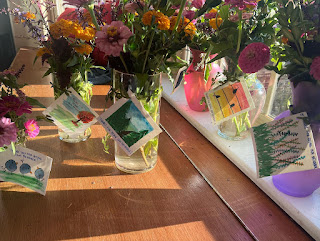Springfield Area Needs More Hopeful Neighborhoods
In a “hopeful neighborhood,” residents work together to discover the gifts of residents, who then imagine the possibilities, and pursue the common good together.
Jennifer Prophete, director of the Hopeful Neighborhood Project, led a four-hour workshop on Feb. 2 in Springfield hosted by the Greater Springfield Board of Realtors (GSBOR) Community Development Committee. The goal was to introduce the concepts of a hopeful neighborhood and discover ways for local relators to make a positive difference in neighborhoods.
“Our goal at the Hopeful Neighborhood Project is to increase neighborhood well-being,” said Prophete. “We can do a lot by being connected to neighbors and building community. We're trying to help people do that by equipping, empowering and teaching them how to collaborate with others.”
Prophete traveled from St. Louis to Republic and Springfield for two days of programs. The first sessions were in Republic and featured water-colored greeting cards to be shared with neighbors. The training on Feb. 2 included training for realtors. The goal was to engage groups who have a vested interest in seeing a neighborhood be clean, safe, and friendly.
At the GSBOR training in Springfield, Prophete ran through the basic concepts of becoming a hopeful neighborhood and asset-based community development. Realtors were asked to think of ways this would apply to their own neighborhoods or where they sell real estate.
Tami Smith, a realtor with Century 21 Integrity Group and GSBOR Zone 4 Community Development Committee delegate, has been learning about being an engaged neighbor over the last year or two in various MU Extension programs.
“I thought I was a good neighbor by keeping to myself. I realize now that good neighbors know their neighbors well enough to be helpful when needed. We need to be interested in each other, and doing so will strengthen the community,” said Smith.
Smith says her “aha” moment during the training came when Prophete discussed being mindful of the “gifts” the neighborhood has and the "gifts" the neighbors have.
“When getting a project or group going, remember a volunteer’s gifts. Don't assign the introvert the most extrovert job,” said Smith.
According to Smith, the training has her thinking about ways to help connect with her neighbors.
“My neighborhood has a mix of older and younger residents,” said Smith. “I can see us working together to revitalize a park in the center of my neighborhood. But I also understand that I must learn about my neighbors’ needs. Maybe my original idea isn't the real need for that neighborhood.”
The training also introduced Smith to tools, resources and possibilities to use in her neighborhood and her business and confirmed her belief that a connected neighborhood is a stronger neighborhood.
Laura Duckworth, a realtor with Flat Fee Redefined brokered by eXp Realty, is chair of GSBOR Community Development Committee. She says the committee’s goal is to create connections in the neighborhoods where they reside.
“Until the workshop, I didn't know the best way to communicate these concepts, but in discussions with the workshop attendees, I know we had a collective ‘eureka’ moment and we left excited by the ideas covered,” said Duckworth.
Duckworth says she was especially struck by the benefit of focusing on the possibilities within a neighborhood instead of getting stuck on the problems.
“We all face negativity daily so we are conditioned to latch onto concerns and deficiencies. We take the good around us for granted, isolate ourselves from our neighbors, or let our differences be a barrier when we do get involved. This deficit-based approach is the norm,” said Duckworth. “But an asset-based approach helps shift the focus in our own neighborhoods to the potential of our community.”
PURSUING THE COMMON GOOD
The first step in
creating a Hopeful Neighborhood is discovering the gifts of your neighbors.
Once discovered, we search for your neighborhood's shared assets or gifts.
“Just helping people understand and gather the assets, that's step one,” said Prophete. “This is a positive type of approach that keeps people engaged.”
Step two is imagining the possibilities by linking our gifts together. What possibilities exist to do something good where we live?
“When you think of neighbors working together, they organize around a problem, try to add some amenity, or have a get-together. Those are all good things, but neighborhood well-being is deeper than a couple of surface things you noticed immediately,” said Prophete.
The third step is making a plan, setting goals, and developing a project.
“People are suspicious. If you suddenly come up and say, ‘I want to do something in the neighborhood,’ they get suspicious. But if you've delivered them cookies and they get a Valentine's Day card from you, and you've been chit-chatting for the last year, you know their gifts already and there is already a trusting relationship to work together,” said Prophete.
The Hopeful Neighborhood Project has training modules online. They also partner with University of Missouri Extension in Greene County to offer neighborhood labs. A lab helps neighbors build an event around their assets that pulls in people of the neighborhood
NEIGHBORING PARTNERS
I first connected with the Hopeful Neighborhood Project two years ago as they were first getting started. Before long, we were cooperating on Missouri Good Neighbor Week, Neighboring 101, and Neighborhood Labs.
We are seeing a growing interest in what it means to be an engaged and hopeful neighbor and how this can positively impact your life.
“It's about
unleashing the potential within people and applauding them along the way,” said
Prophete. “We get there faster when we look at the gifts and talents in the
neighborhood and the existing assets, instead of focusing on the challenges.
It's not difficult to go into a neighborhood and get people to tell you the
problems, but if you start there, getting them to help you solve them is
difficult.”
###





Comments
Post a Comment